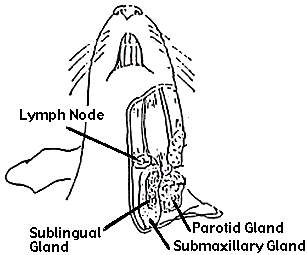Rat Anatomy - Structures of the Head and Neck

1. Locate the salivary glands, which on the sides of the neck, between muscles. Carefully remove the skin of the neck and face to reveal these glands. Salivary glands are soft spongy tissue that secrete saliva and amylase (an enzyme that helps break down food). There are three salivary glands - the sublingual, submaxillary, and parotid.
2. Find the lymph glands which lie anterior to the salivary glands. Lymph glands are circular and are pressed against the jaw muscles. They are not always visible in the rat.
3. Tease away the muscles of the neck to reveal the trachea. The trachea is identifiable by its ringed cartilage which provides support. The esophagus lies underneath the trachea, though it is easier to locate in the abdominal cavity where it enters the stomach.
4. Locate the larynx, which is just anterior to the trachea. The larynx is the voice box, and it allows rats to making squeaking noises.
Procedure: Pin the structures of the head and neck - salivary glands, trachea, and lymph nodes (if visible)
Checkpoint (External Anatomy, Muscles, Bones, and Neck):
1. What are the four bones in the hind limb of the rat? ___________________________
2. What are the three bones in the forelimb of the rat? ___________________________
3. Where does the trachea lead? ___________________ The esophagus? ______________
4. What feature do you find on females, but not males? ________________
5. What tendon connects the gastrocnemius to the calcaneus? ______________
6. What muscle was removed to expose the femur? __________________
7. What two muscles can be found on the dorsal side of the rat? __________________
8. What muscle covers the ventral, abdominal region? ______________________
9. What muscle covers the ventral, pectoral region? ________________________
10. What structure is responsible for rat vocalization? ______________________
Other Resources on the Rat
Rat Pages: Rat Introduction and Guide | Rat External Anatomy
Head | Abdominal Cavity | Circulatory System | Urogenital System
Other Resources: Virtual Rat Dissection

